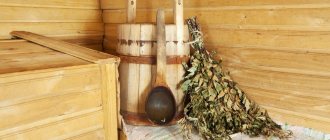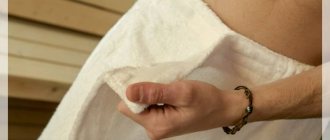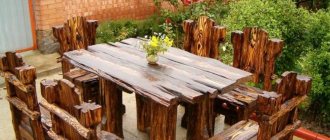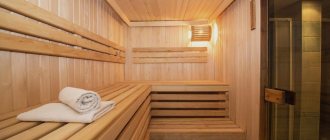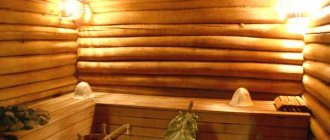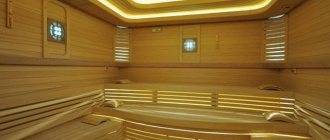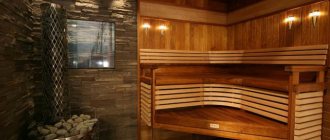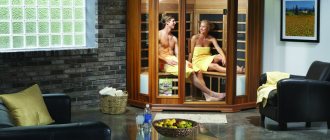Experts say that nothing adds dignity to even the most unprepossessing person like horn-rimmed glasses, a smoking pipe and a robe. Glasses and a pipe are not appropriate for our department, but a robe is just what is needed. Still would! Remember the expression “terry”? And this can be not only a bathrobe, but, for example, a specialist in the bath business, who has worn out a dozen bathrobes in his time, and as you know, you can’t waste experience.
Bathrobe
This robe is thrown on after leaving the shower or bath to quickly dry and not freeze; it is usually velor or terry.
It is considered normal if the composition contains, in addition to natural ones, synthetic materials - it is important that their amount does not exceed fifty percent. Thanks to the moderate admixture of synthetics, things wrinkle less and hold their shape better. A robe made mostly of synthetics does not absorb water well, the removal of which from the surface of the skin is the main task of a bath attire.
For summer, a robe made of loose terry is suitable, for winter - something made of thick fabric. Bathrobes, as a rule, have a simple cut. Usually this is a model with a wrap and a belt, sometimes with pockets and a hood. The colors of this robe are in calm, pastel, often light colors.
Bathrobes can be designed for men or women, but more often they are universal unisex models. They are also sewn for children: in bright and soft colors or with prints in the form of cartoon characters. You can take your children's bathrobe with you to the beach and use it as a towel.
Reviews
Most people prefer terry bathrobes to other types. This is due to the special fluffiness of the fabric and soft villi - loops that easily massage the skin without causing irritation. At the same time, this fabric absorbs water well.
Opinions on the naturalness of the product or the use of semi-synthetic terry fabric are divided. In general, most complain that the quality of products on the market has decreased in recent years.
Linen robes are preferred by people with higher incomes. Many people note that a bathrobe comes in handy not only in the bathhouse, but also in the sauna and at home after a shower.
House dressing gowns
As a rule, a dressing gown is worn constantly and for a long time, so you need to be especially careful when choosing it.
The cut of dressing gowns for the home is more elegant and complex than that of bathrobes. They can be zippered, with flared sleeves, long or short. There are no restrictions on the decoration of a dressing gown; they can be embroidered with beads or silk ribbons.
- For household chores, women often choose an analogue of a robe - a chlamys. These are loose loungewear with medium-length sleeves that are pulled over the head and do not have fasteners.
- Thin, flowing robes made from natural silk are constantly swaying and moving, so they are not particularly suitable for work. But this is the most beautiful of all options. Natural silk is a rather expensive material, but it provides air circulation and retains heat much better than artificial silk.
- Cotton robes are light, comfortable to wear and the most practical.
- A knitted robe with a hood is chosen by those who are comfortable with a sporty style.
Tailoring to the rescue
If you don’t even have much experience in sewing, but don’t have enough money to buy a bath robe made of quality material, don’t worry. Experienced craftswomen claim that sewing a robe with your own hands will not be difficult even for a beginner. And you can save money, because you will only have to spend money on fabric. But when choosing material, try not to waste time on trifles so that the product turns out to be of high quality. The process of cutting and sewing a bathrobe is quite simple, but an important requirement: you must have a sewing machine that can sew thick terry fabric. Otherwise, you will have to settle for not so warm options for bath clothes. Ideally, you also need an overlocker to finish the edges of the fabric so that the lint does not come out along the edge. But if you really want to sew something new and don’t have an overlocker, you can do without it.
The advantage of sewing a classic version of a bathrobe is that the model is simple: there are no side seams or darts, which saves fabric and makes the task easier for beginners. On the Internet you can easily find a pattern for a classic robe that suits women and men equally well. Only in the men's version, which provides a right-sided smell, and you will need to move the pocket to the left side.
The first step is to decide on the amount of fabric you need to sew a bathrobe. To do this, you need to know exactly the length of your future bath product and the length of the sleeve. Fabric width: you will need one and a half meters (this is a fixed roll width). You will find out the total length of the fabric if you add the length of the product to the length of the sleeve.
It will be difficult for you to measure the length of your future bathrobe on your own; ask someone from your family for help. To do this, you need to apply a tailor's measuring tape from the back to the base of the neck (the place where the neck meets the shoulder) and measure down as much as you think is necessary (above the knee or below). And the length of the sleeve is determined from the wrist to the protrusion where the arm meets the shoulder.
After you have specified all the dimensions that are needed, draw the pattern on special paper or on a piece of wallpaper roll. If you find a pattern for a bathrobe on the Internet or in a handicraft book, but its size does not suit you, then add the required number of centimeters to the data presented in it. For example, if your size is two smaller, then subtract 2 centimeters from the back and 2 centimeters from one shelf. Conversely, add a centimeter for each size you are missing. You should have the following pattern elements drawn: two shelves; back; two sleeves; two belt loops; one belt; one pocket; one loop; two collars that go into the collar; one lower back part of the collar. Since chalk drawing on terry cloth is difficult, you can attach the cut out listed pattern pieces directly to the material using pins.
Cut out the parts from the fabric, leaving one and a half centimeters for allowances.
How to choose a terry robe: the most important thing
Terry fiber has good moisture-absorbing and warming properties, which is why it still remains the most popular material in the production of bathrobes.
Terry is essentially cotton, but often with various admixtures: bamboo fiber, modal or synthetics. Accordingly, terry robes are conventionally divided into classic (100% cotton) and mixed (with the addition of other fibers).
- Bamboo is known for its bactericidal properties; in addition, it has excellent air permeability and absorbs water. Bathrobes with the addition of bamboo are very soft and comfortable for the skin.
- Synthetics (for example, acrylic or polyester) give terry fabric softness. Bathrobes with a small admixture of synthetics are softer and more pleasant than those made from pure cotton. Another plus: the item becomes lighter and wrinkles less.
- Modal is a fiber made from beech and eucalyptus wood. It is twice as hygroscopic as cotton and maintains the appearance of the product longer - it does not stretch or lose color even after many washes. Robes with modal are soft to the touch and almost weightless. The only and significant disadvantage is the price. Such robes cannot be called a cheap option.
Special care regimen
A high-quality robe will not be a cheap pleasure, and therefore it is very important to properly preserve it so that it pleases its owner for as long as possible.
Washing and storage
Despite the word “bath” in the name, it is recommended to store it away from moisture, and therefore the bathroom is definitely not suitable. The robe will feel best in the bedroom, etc., where there is no excessive humidity and it is possible to regularly ventilate the room. This is necessary in order to prevent the possible development of bacteria on the fabric if the pile is not dry enough.
You can store the bath product on a hanger in the closet. It can also be folded and thus placed on a shelf. But there is a note for bath clothes with embroidery: it is advisable to store them folded with the embroidery up, not down. To maintain the fluffiness of your terry bathrobe, it is recommended to shake it lightly every time you remove it from your body after a shower and hang it up to dry.
How to protect a product from premature wear when washing
| How to wash bathrobes | What to pay special attention to |
| What temperature and spin should be set in the washing machine. | You can use a washing machine, but only at a temperature not exceeding forty degrees and in the “delicate wash” mode. Machine spinning is permissible at a speed of no more than 800 rpm. |
| If you plan to wash a robe with embroidery. | Turn it inside out to prevent damage during machine washing. |
| Try not to wash terry cloth with other items. | This is especially important if they have any zippers or hooks, as lint can get caught in them and come out. |
| What detergents to choose. | It is recommended to use liquid detergents when washing bathrobes. If you only have washing powder, then at the end of the wash you will have to set an additional rinse mode, or even twice, in order to completely wash out the remaining powder from the lint. |
There are situations when clothes are hopelessly dirty and cannot be cleaned without additional efforts. But in this case it should not be twisted or rubbed too hard. If your perfectly white robe is dirty, then you can use bleach during washing. But this method will only work if there is not a single colored detail on it, including embroidery. Otherwise, bleach can ruin an expensive item. During normal washing, such a robe should be washed using products intended for colored laundry. They act more delicately. For difficult stains, you can use stain remover locally: first pour it onto the stain and then add it to the washing machine tray when washing. But a conditioner containing silicone will help improve the overall appearance of a terry bath product. It will increase the fabric's ability to absorb moisture and also add softness to the surface.
Drying and ironing
It is recommended to dry terry bathrobes in the fresh air. This fabric is quite heavy and takes a long time to dry, and under the influence of a slight breeze the process will speed up significantly. But it is strictly not recommended to dry them on a radiator or on a heated towel rail, as this will make the pile harder. A similar ban is imposed on ironing terry bath robes. You can only lightly walk on the surface with steam.
Bathrobes are very popular among many people, and therefore they are considered one of the best gift options - this item will definitely come in handy in any family. Depending on the material used to produce the product, such a bath accessory can cost a pretty penny. To save a little, you can go in two ways: buy this piece of home clothing from non-natural components, or sew it yourself from high-quality expensive fabric. The second way is more recommended, since artificial materials can harm your health in a hot bath. But if you do not plan to wear such a robe in a sauna or bathhouse, but will simply use it at home as comfortable clothing, then you can neglect the strict rules for choosing a product. In the same case, if you want to buy a terry robe for a child, try not to save money, since the delicate skin of babies is more susceptible to allergic reactions to chemical components.
Experts recommend washing children's bathrobes weekly if these items are constantly worn. In the case of adult products, the number of washes can be reduced to two, or even once a month. And don’t forget to follow the simple instructions for washing and drying terry items so that they don’t get damaged.
